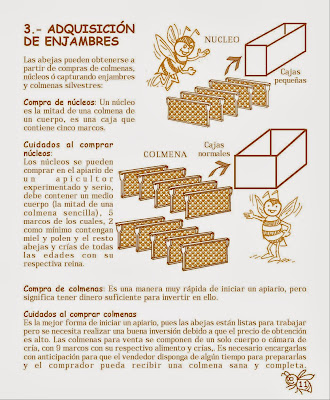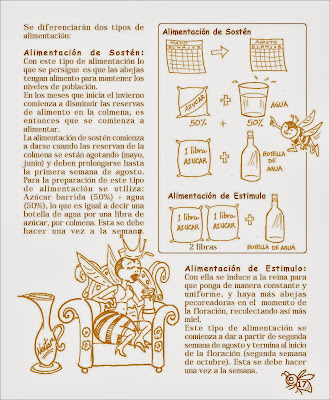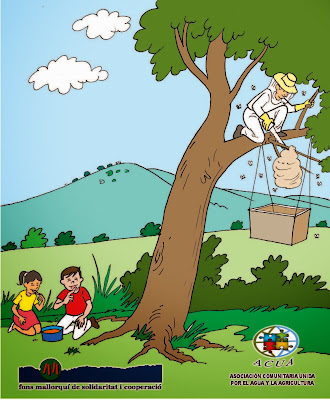Las abejas, una sociedad perfecta - Bees, perfect society
Aparentemente, la sociedad de las abejas sería una sociedad perfecta. Aceptemos que así sea y analicemos por qué ello es posible.Todas las abejas parecen entenderse entre sí y cada una desempeña un rol específico sin que éstos se superpongan, de modo que del trabajo conjunto se deriva una vida armónica para la colonia.
Llaman también la atención la especialización del trabajo y la perfecta limitación de los roles y responsabilidades de cada una. Por otra parte, todas parecen sentirse tranquilas, porque poseen un perfecto sistema de defensa frente a agresiones externas.
Desde el punto de vista biológico, llama la atención la perfección de sus sistemas de comunicación, en que la información rápidamente alcanza una total cobertura y el mensaje tiene para todas un mismo significado.
Tienen un sistema de comunicación perfecta a través de feromonas, y un eficiente sistema de defensa de la comunidad frente a cualquier agresor. Una abeja, al picar al agresor, se sacrifica y debe morir, pero junto con eso libera una feromona que estimula la agresividad de toda la colonia que sale a la defensa. Tal vez la característica más importante y que da mayor estabilidad a esta sociedad es la jerarquización de las estructuras, junto a la división del trabajo, con roles perfectamente definidos.
En ellas se desdibuja el individuo, para tomar importancia la sociedad como un todo. Se ven incluso altruismos supremos que llevan hasta la muerte individual en beneficio de toda la sociedad.
Lo que llama la atención es que las colonias no son pequeñas y tienen por lo general miles de individuos.
Sobre las abejas encontramos un texto de Dídimo de Alejandría, (autor de las Geórgicas Suda, en 15 libros. Vivió a finales del siglo IV o comienzos del V. Posiblemente fue también médico ya que se le cita en el siglo VI por los médicos Alejandro de Tralles y Aecio, los que le atribuyen la autoría de otra obra llamada Octátomo o Libro de los ocho tomos), que las describe en un decálogo de la siguiente forma:
-La abeja es el más sabio e industrioso de todos los animales, muy cercano al hombre por su entendimiento; y lo elaborado por ella es en verdad divino y sumamente útil para los hombres.
-Incluso la organización política de este animal se asemeja a las ciudades regidas por las mejores leyes.
-Pues lleva a cabo sus salidas bajo la dirección de un jefe y siguiendo un orden; y acarreando de las flores y los árboles las savias más viscosas, embadurnan con ellas como con ungüento el suelo y las entradas, dedicándose unas a la miel y otras colaborando en cualquier otra tarea.
-El animal es también limpio hasta la exageración y no se acerca a ninguna sustancia maloliente ni sucia; no es glotón y no acude a la carne ni a a la sangre ni a materia grasa alguna, sino solamente a lo que tiene un jugo dulce.
-Tampoco estropea el trabajo de otros, rechazando no obstante con energía a los que se aplican a estropear el suyo.
-Consciente de su debilidad, construye los accesos a su casa angostos y con un trazado tortuoso. Así pues, a los que entran para hacer daño los rodean entre varias y los matan con facilidad.
-A este animal le fascina también la bella música, por lo cual los músicos, tocando el címbalo o batiendo rítmicamente las palmas, las congregan aunque estén dispersas.
-Este animal es el único que busca un jefe que cuide de la comunidad, razón por la que siempre honra a su rey, lo obedece con celo en lo que ordene, lo sostiene cuando está enfermo y cuando no puede volar carga con él y lo defiende.
-Aborrece sobremanera a los perezosos, por eso matan entre todas a las que prefieren el ocio y gastan el producto de su trabajo.
-Pero su habilidad y proximidad a la inteligencia racional se ve sobre todo en que hace sus celdas hexagonales.
Las abejas, una sociedad perfecta - Bees, perfect society
Apparently the bee society would be a perfect society. Accept that so and analyze why this is possible.
All the bees seem to understand each other and each plays a specific role without them overlap , so that the joint work we derive a harmonious life for the colony.
They also draw attention to the specialization of labor and the perfect limiting the roles and responsibilities of each. Moreover, all seem to be peaceful , because they have a perfect system of defense against external aggression.
From the biological standpoint , struck by the perfection of their communication systems , in which information quickly reaches full coverage and the message has the same meaning for all .
They have a perfect communication system through pheromones, and an efficient system of community defense against any aggressor. A bee , by biting the aggressor , sacrifices and must die , but along with that release a pheromone that stimulates the entire colony aggressiveness that comes to defense. Perhaps the most important feature that gives greater stability to this society is the hierarchy of structures, along with the division of labor , with clearly defined roles .
They blur the individual to gain importance society as a whole. They look even supreme altruism leading to the individual death benefit of the whole society.
What is striking is that the colonies are small and usually thousands.
About the bees find a text of Didymus of Alexandria , (author of the Georgics Suda, in 15 books . Lived in the late fourth or early Possibly V. was also doctor as he is quoted in the sixth century by doctors Alejandro of Tralles and Aetius , who attributed the authorship of another work called Octátomo or Book of the eight volumes) , which are described in a Decalogue as follows :
-The bee is the wisest and industrious of all animals , very close to the man by his understanding, and prepared for it is truly divine and extremely useful for men.
-Even the political organization of this animal resembles the cities governed by the best laws .
-Well conducts its outlets under the direction of a chief and following an order , and carrying flowers and trees saps more viscous , smear them with ointment as soil and tickets , dedicating each honey and other collaborating in any other task.
-The animal is also clean to a fault and does not approach any smelly or dirty substance , not greedy and does not attend aa flesh and blood or fat at all, but only you have a sweet juice .
-Nor spoils the work of others, however forcefully rejecting those who apply to damage yours.
-Aware of his weakness , builds home access to a narrow and tortuous course . So those who enter to harm those around between several and kill them easily.
-This animal also loves beautiful music , so musicians , playing the cymbal or rhythmically beating the palms, but are scattered flock .
-This animal is the only one seeking a leader who cares for the community, why always honors his king zealously obey him in what order , what holds when sick and when loaded can not fly with him and defends .
-Greatly hates the lazy , so to kill between all who prefer leisure and spend the fruits of their labor .
-But his skill and proximity to rational intelligence is mostly seen in their cells doing hexagonal.




































